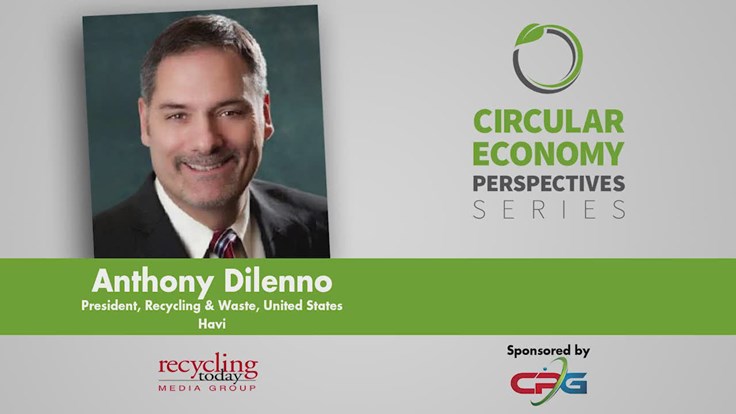From left to right (L-R): John Carlton of Gershman, Brickner and Bratton, acting a moderator for the panel; Mike Powlowski of PHG Energy; Tim Cesarek of Enerkem; Craig Stuart-Paul of Fiberight; and P. John Ruth Jr. of CTBH Partners LLC
The public private partnership model allows both the public and private sectors to take some responsibilities for the risk and rewards of waste conversion projects. In the session “Sharing the Risks and Rewards—the Public Private Partnership Model,” at the Renewable Energy from Waste Conference in Long Beach, California, on Nov. 16, several businesses outlined how public private partnerships have benefited them.
“When you stand alone, you get the status quo, you may make modest improvements,” Mike Pawlowski of PHG Energy, Nashville, Tennessee, said during the panel. “But with [public private partnerships], you make incremental improvements. When you allow each to do what their best at, you succeed.”
PHG Energy worked with the city of Lebanon, Tennessee, to develop a gasification project that processes 32 tons per day—3 tons of sludge, 3 tons of tires and 26 tons of wood waste. The facility can process up to 64 tons per day.
The city of Lebanon operates the facility, Pawlowski said, and are able to plan, coordinate and finance projects. PHG Energy is the technology provider and operator. The city gets its feedstock from Rockwood, a provider of wood waste and tires who collects the materials and hauls them to the plant.
The gasification plant uses three of PHG Energy’s Organic Rankine Cycle (ORC) system to create 140 kilowatts each and the biochar can be used as a soil amendment or kiln fuel.
Montreal, Quebec-based Enerkem exemplified its public private partnership model with several projects, focusing on its Edmonton, Alberta, facility. Senior Vice President of Business Development Tim Cesarek said that the city’s implemented recycling efforts made them “complementary” to Enerkem’s biofuels production.
Edmonton has a curbside black bag/blue bag program, where residents put recyclables in blue bags or bins and other waste in black bags or bins. According to Cesarek, the city had the desire to divert waste since the early 1990s when it started composting and looking into waste-to-energy technology.
“It has been a great city to work with,” he said. “The residents are engaged in learning about the technology needed to create ethanol.”
The facility can turn 100,000 dry metric tons of municipal solid waste (MSW) into 38 million liters of ethanol per year, but it will not start producing ethanol until 2017. At the moment, it produces biomethanol.
Enerkem also announced a collaboration with the city of Rotterdam in the Netherlands, with 11 partners involved. It will be a carbon recycling facility.
Fiberight, Cantonsville, Maryland, built a relationship with the Maine Municipal Review Committee (MRC) after the committee ended a 9-year contract with Penobscot Energy Recovery Facility for a waste-to-energy facility.
The committee represents 187 communities in Maine and wanted a waste-to-energy facility in Hampden, Maine, to turns those communities’ municipal waste into sugars and biofuels. While the committee didn’t want to use municipal funds for the project, they called for something “future proof,” a project that could be profitable years down the road. In return, Fiberight called for enough tip fee revenue to cover debts, services and operating costs.
“We needed to incorporate risk-sharing in things like change of law,” Cesarek said.
Fiberight built and operates the facility, markets all the recovered materials and handles the disposal of the materials while the MRC committee guarantee tonnages and tip fees, manage logistics and engages the community in outreach and education.
Construction on the project started in October 2016.
P. John Ruth Jr., founder and managing partner of Hanover, New Hampshire-based CTBH Partners LLC, lent his advice on how the public and private sectors can finance these projects. Government incentives, he said, include grants, tax increment financing and exemptions, offtake and/or feedstock agreements, special property tax assessments and tax credits.
In this session, Ruth focused on private activity bonds (PABs)—a tax-exempt bond issued by local or state governments for providing special finance benefits for projects, including solid waste and recycling facilities, airports, docks and wharves and sewage treatments.
Each state has a limited capacity of private activity bonds they can issue, Ruth said, and any funds that are left over from the PAB issuance can be carried over for three years, as long as the state “blesses your project.”
PABs provide an alternate financing source for a public private partnership that otherwise may not be available, allowing public private partnerships that would be pushed the wayside to get a chance.
The Renewable Energy from Waste Conference took place Nov. 14-16 at the Westin Long Beach in Long Beach, California.



